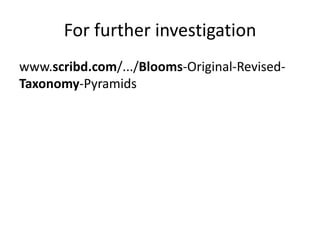
A) bloom's taxonomy_class_protocol
- 1. For further investigation www.scribd.com/.../Blooms-Original-Revised-Taxonomy-Pyramids
- 2. 1-3 levels of Bloom's Cognitive Domain and the corresponding verb examples: Remembering: arrange, define, duplicate, label, list, memorize, name, order, recognize, relate, recall, repeat, reproduce, state. Understanding: classify, describe, discuss, explain, express, identify, indicate, locate, recognize, report, restate, review, select, translate. Applying: apply, choose, demonstrate, dramatize, employ, illustrate, interpret, operate, practice, schedule, sketch, solve, use, write.
- 3. 4-6 levels of Bloom’s Cognitive Domain and the corresponding verb examples: Analyzing: analyze, appraise, calculate, categorize, compare, contrast, criticize, differentiate, discriminate, distinguish, examine, experiment, question, test. Evaluating: appraise, argue, assess, attach, choose compare, defend estimate, judge, predict, rate, core, select, support, value, evaluate. Creating: arrange, assemble, collect, compose, construct, create, design, develop, formulate, manage, organize, plan, prepare, propose, set up, write.
- 5. Affective Domain Skills in the affective domain describe the way people react emotionally and their ability to feel another living thing's pain or joy. Affective objectives typically target the awareness and growth in attitudes, emotion, and feelings. There are five levels in the affective domain moving through the lowest order processes to the highest.
- 6. 5 levels of Bloom’s Affective Domain Receiving: The lowest level; the student passively pays attention. Without this level no learning can occur Responding: The student actively participates in the learning process, not only attends to a stimulus; the student also reacts in some way. Valuing: The student attaches a value to an object, phenomenon, or piece of information. Organizing: The student can put together different values, information, and ideas and accommodate them within his/her own schema; comparing, relating and elaborating on what has been learned. Characterizing(Attitude): The student holds a particular value or belief that now exerts influence on his/her behavior so that it becomes a characteristic.
- 7. Class Protocol During the first 2 weeks the class will: start with information items, questions and answers, and an explanation of what we will be focused on. have directed learning followed by guided learning followed by group learning followed by individual learning and assessment
- 8. Weeks 3-6 will: start the class with information items, questions and answers, and an explanation of what we will be focused on. have directed learning followed by guided learning that will be thinned followed by group learning that will be expanded followed by individual learning and assessment
- 9. Course Student Learning Outcomes Philosophy 20 Ethics 1. Student will demonstrate the ability to explicate, analyze, compare, and evaluate a variety of theories in normative ethics or meta-ethics using rigorous philosophical methods. 2. Students will demonstrate the ability to apply moral theories and concepts to contemporary problems such as war, capital punishment, euthanasia, poverty and others. 3. Students will embody the qualities of an open-minded but critical thinker in the examination or formation of their moral philosophy.